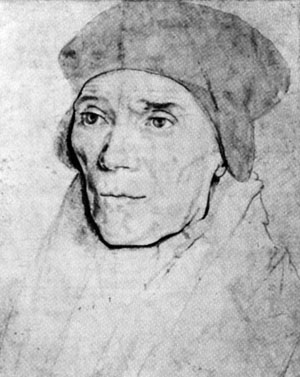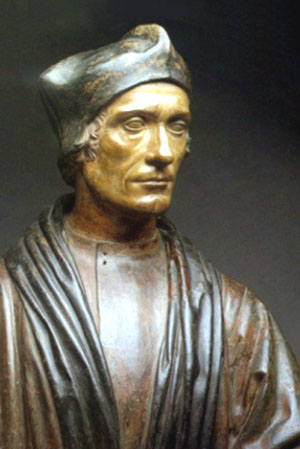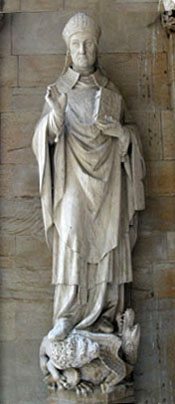 |
The Saint of the Day
St. John Fisher – June 22
Prof. Plinio Corrêa de Oliveira
Biographical selection:
St. John Fisher (1469-1535), Bishop and Martyr, Cardinal-Bishop of Rochester was beheaded by order of the King Henry VIII on June 22, 1535, who hated the Catholic Faith and the Sovereign Pontiff.

A pencil sketch of St. John Fisher
by Hans Holbein the Younger
|
He was chaplain to the mother of Henry VIII and chancellor of Cambridge University before being elevated to the bishopric of Rochester in 1504. He counted Thomas More among his friends. John Fisher opposed the divorce between Henry VIII and Catherine of Aragon and the constitution of the so-called Anglican Church.
Because he refused to swear an oath affirming the supremacy of the king as Supreme Head of the church of England, he was imprisoned in the Tower of London. There, on May 20, 1535, he received the title of Cardinal granted him by Pope Paul III. The following day, he was condemned to death by torture, but this penalty was changed to beheading because the 66-year-old Cardinal was ill and too weak to endure torture.
On the early morning of June 22, he was awakened by the Tower commander, who told him that the King had decreed his death sentence. St. John Fisher responded:
“Very well, this is no news. I was expecting it. What time is it now?”
“Around 5 a.m.”
“What time will the execution be?”
“At 10 a.m.”
“Then I would be grateful if you would let me sleep a few more hours, since I did not sleep well - not because of fear, but due to my illness and weakness.”

Above, the Tower of London where
St. John Fisher was imprisoned
|
When the officer returned around 9 a.m., he found Fisher standing and dressed. The holy Prelate took the New Testament and read aloud the words of St. John:
“Now this is eternal life: That they may know Thee, the only true God, and Jesus Christ, whom Thou hast sent. I have glorified Thee on earth; I have finished the work which Thou gavest me to do. And now glorify Thou me, O Father, with Thyself, with the glory which, before the world was, was with Thee” (John 17:3-5)
Afterward, St. John Fisher asked to be given his mantle. The officer said:
“My lord: why do you show concern over your health when your time is already counted and you have only one hour of life?
The Prelate responded:
“I requested my mantle to keep myself warm until the moment of my execution so that I do not harm my health by my own doing in any way.”
He was taken out for the public execution, and walked resolutely to the scaffold. Raising his emaciated body erect, he asked in an audible voice for the onlookers to pray for him:
“Until now I have not feared death. I am, however, made of flesh, and because of the flesh, St. Peter denied Our Lord three times. I ask you to assist me with your prayers so that at the very point and instant of the death stroke, I may in that very moment stand steadfast without forsaking any one point of the Catholic Faith.”
On the scaffold, he was offered pardon repeatedly if he would renounce his position, but he remained inflexible.
After he was beheaded, his naked corpse was displayed to the public for an entire day. His head was set on a lance and placed on London Bridge. Fifteen days after his martyrdom, his head still appeared alive and fresh. When the people started to acclaim this as a miracle, it was thrown into the Thames.
John Fisher and Thomas More were beatified in 1886 and canonized in 1935. Their feast is commemorated jointly.
Comments of Prof. Plinio:
You see the reactions of the soul of a great Prelate who would soon be murdered, the reactions of a saint before the terrible fact of death. Someone who says that he does not fear death – unless he has a special supernatural grace - is lying, because, death is per se a chastisement instituted by God to punish mankind for original sin. Therefore, it is proper for man to fear death.

St. John Fisher, stalwart in face of death
|
Death is the rupture of the most fundamental unity of the human being, which is the unity of body and soul. This separation is a fact that implies an unimaginable suffering and pain. If twisting a muscle or dislocating a bone can cause an enormous pain, you can imagine the pain the body suffers when the soul leaves the body. Such a separation is a terrible thing. So, it is normal for a person who faces reality to have fear of this singular moment.
Another terrible aspect of death is that in his death agony, depending upon the sickness, the person can fall into a kind of torpor where he is no longer aware of the external reality. He can lose consciousness of almost everything. In such a state, who knows what things he is thinking about? What kinds of trials, temptations and fears might he be subject to?
You understand that it is natural, therefore, for a person to fear death.
Now, consider the admirable degree of vigilance of St. John Fisher in his last hours. He received the news of his approaching death with a supreme calmness, then went back to sleep. This reflects a superb tranquility of conscience. It reminds me of an incident that occurred when St. Aloysius Gonzaga was a child playing ball. When someone asked him what he would do if he knew that the world would end in 15 minutes, he answered: “I would continue playing ball.”
Likewise, when St. John Fisher received the news of his approaching execution, he said: “Very well, but I am tired, let me return to my sleep.” His response was quite different from those who think a man should enter into frenetic prayer when he knows that he will die soon. St. John Fisher did something quite different. By his action, he taught: “I am at peace with God. I have already said all my prayers. So, let me sleep tranquilly, because my soul is already prepared to be in the presence of God.” It is an admirable manifestation of tranquility of conscience. But it is also a manifestation of an extraordinary supernatural assistance that spared him the fear of death.
He slept, awoke, dressed, and presented himself serenely before the officer who came to lead him to death. He asked for his mantle, and the officer asked him why he should be concerned about catching a cold. In St. John Fisher’s reply, you see a bit of the famous English humor, a quick rejoinder to the sarcasm of the officer. The real reason he asked for his mantle was that when a person is cold and hungry, his body can easily tremble, and this could give the impression at the execution that he was afraid. So, St. John Fisher wanted to be warm so as not to shiver and give this impression.
Then he went to the place of torment and asked the people to pray for him - that he should not have fear. He was not afraid, but because he was aware of his human weakness, his vigilance prompted apprehension of a possible future fear. He feared losing that magnificent state of soul that he possessed at that moment. He suspected himself and solicited the prayers of the onlookers.

Statue of the saint at St. John's College, Cambridge
|
He was right to do this, because in his last moments at the scaffold many seductive proposals were made for him to renounce his position and deny the Catholic Faith. He refused them all. Why was such insistence made at the scaffold? Because the enemies of the Faith also understood human weakness and knew that this at this moment he might be pressured to renounce his position. If he would deny his stand, it would be a great triumph for the Anglican cause. Both St. John Fisher and the enemies of the Faith knew that if he would compromise, he would walk away from the scaffold and receive great honors and wealth.
But he was prepared for those proposals because he had feared the temptation he might experience. So, practicing the virtue of vigilance, he followed the counsel of Our Lord - to be as vigilant as the serpent – and he asked for the prayers of the people. He realized that he could still fall and that he needed the prayers of others, primarily the intercession of Our Lady.
After he was beheaded, his head was displayed on London Bridge. But after 15 days it still maintained the appearance of life, which was certainly a miracle. The bad faith of the heretics was manifest in the fact that, instead of converting, they threw his head into the Thames.
Once again England exercised an act of hardness of heart, defying the Catholic Church, who amiably tried to preserve it in her bosom.
We should have the same state of spirit of St. John Fisher. Thank God we are devotees of Our Lady and struggle to be good Catholics. But this does not give us the guarantee that we will not be tempted. We must always pray to resist and conquer the temptations that may come, realizing that each man made of flesh is weak. For this reason we should ask Our Lady to assist us always, but principally at the hour of our death. The grace of a good death is a special grace that should be prayed for with perseverence since no one knows the hour of his own death. Let us do this without fear, in peace and tranquility, as St. John Fisher did.
These are some thoughts that the death of St. John Fisher suggests.


  | | Prof. Plinio Corrêa de Oliveira | |
The Saint of the Day features highlights from the lives of saints based on comments made by the late Prof. Plinio Corrêa de Oliveira. Following the example of St. John Bosco who used to make similar talks for the boys of his College, each evening it was Prof. Plinio’s custom to make a short commentary on the lives of the next day’s saint in a meeting for youth in order to encourage them in the practice of virtue and love for the Catholic Church. TIA thought that its readers could profit from these valuable commentaries.
The texts of both the biographical data and the comments come from personal notes taken by Atila S. Guimarães from 1964 to 1995. Given the fact that the source is a personal notebook, it is possible that at times the biographic notes transcribed here will not rigorously follow the original text read by Prof. Plinio. The commentaries have also been adapted and translated for TIA’s site.
|
Saint of the Day | Home | Books | CDs | Search | Contact Us | Donate

© 2002- Tradition in Action, Inc. All Rights Reserved
|
 |

|